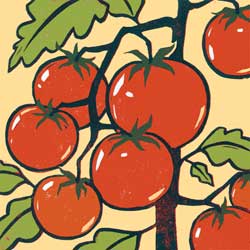Red Is the Color | Mary’s Farm
Last year was one of the worst years for hay that I can remember. Aside from the need for sun to dry the hay before baling, these fields are wet anyway, so if it rains too much, the fields are too wet to bear the weight of a tractor. So the farmers wait for that […]

Last year was one of the worst years for hay that I can remember. Aside from the need for sun to dry the hay before baling, these fields are wet anyway, so if it rains too much, the fields are too wet to bear the weight of a tractor. So the farmers wait for that longed-for stretch of hot, dry weather. Here, we waited all through July–the wettest July on record–and into August before it seemed possible to cut and dry and bale. Even now the memory of that time is left in the fields in ruts so deep the words of the tractor are written in the earth.
A bad year for the garden, as well. For the past several years, I’ve belonged to a CSA–a “community-supported agriculture” group. The concept is simple: Members purchase a share of the farm and in return receive a bushel of produce. A basket is left on my porch each week, the vegetables–peas, tomatoes, squash–fresh from the garden as they ripen. Everybody wins.
This also answers the sensible call to buy local. The produce is from the same earth we till here; it hasn’t been shipped thousands of miles to reach my table and forced to ripen along the way. Supporting local agriculture is a simple idea, perhaps even self-evident, yet it has become a movement, an agenda that stirs passions among the committed, inspires bumper stickers and banners.
But I still plant a garden–tomatoes, basil, parsley, summer squash, cucumbers–the things I need more of than what comes to me in the basket. I love to can tomatoes, for instance, for use throughout the winter. The year before last, I was able to put up 30 quarts, plus plenty more for salads and slicing. These tomatoes, in particular, were unusually beautiful–perfect red orbs, no blemishes or cracks or worms. Some even seemed heart-shaped. In fact, they were so gorgeous, so catalogue-perfect, that I posed them for pictures, wicker baskets full of happy fruit. I even had a bumper crop of green tomatoes, their season cut short by frost. Wrapped in newspaper and stored in the basement, these went in unripe and came out, weeks later, red and juicy. That’s what I call the end of a good year.
But then came last year, rainy and cold, the tall hay standing in the field, blown over and flattened by each nasty storm. It was all a sorry sight. In my garden, the nascent tomatoes hung sullen. (Puppy Harriet picked them off the vines as fast as I could turn my back.)
Our summer ended with few ripened fruits, nothing like the abundance of the year before. We shivered through many a July and August day, which made some of us cranky. The produce from the basket wasn’t much better than what I grew here–that is to say, disappointing. I did no canning. In another time, even 100 years ago, we would have been facing a hungry winter. No matter how technologically sophisticated our world becomes, no matter how global, we still have to rely on the unpaved, still-fertile soil beneath us to provide, just as Benjamin Mason did when he first worked the land here in 1763. I’m sure his first crops were meager. But each year must have strengthened the harvest. If that were not so, I wouldn’t be here now, surrounded by open fields that still bear crops, fields that Mason opened by clearing virgin forest with an axe. It all would have been forsaken by successive farmers, and long ago it all would have grown back to woods. But the hay still grows tall, and the tomatoes blossom and bear fruit the color of anger, the color of passion, the color of love.


